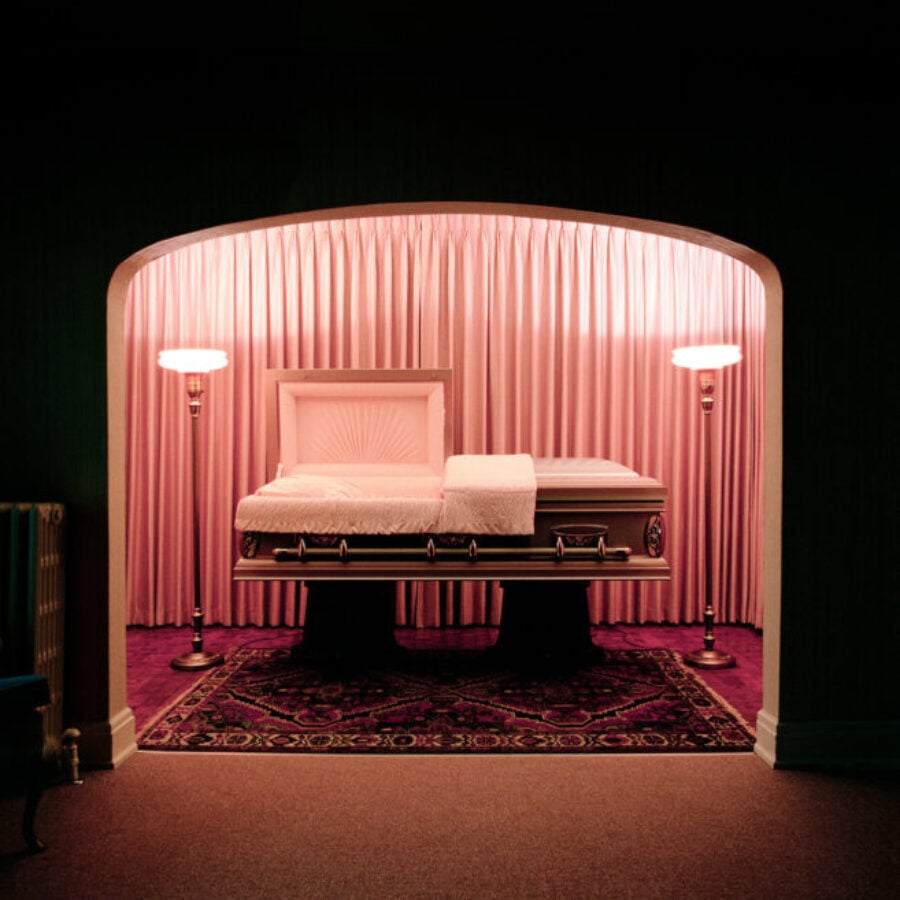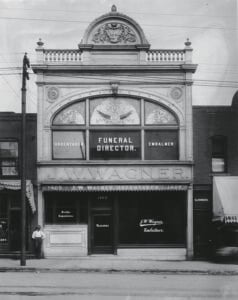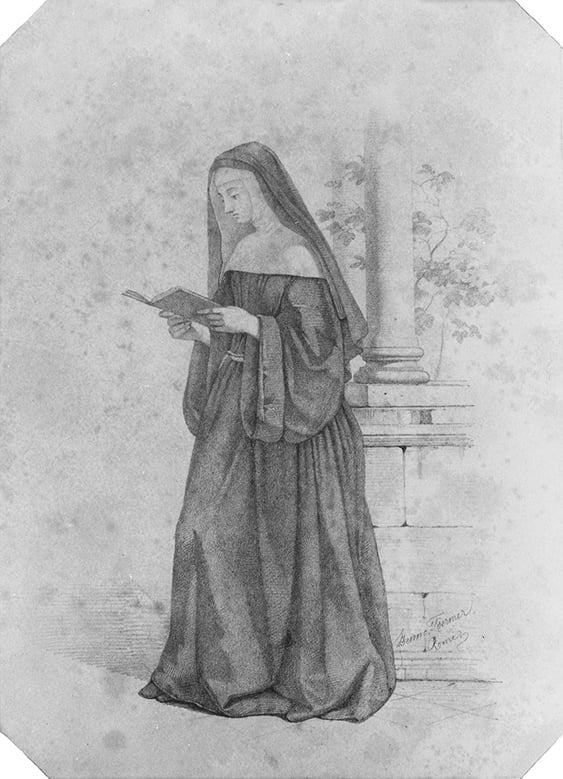
“Casket Showroom, Carter Funeral Home, Syracuse, NY, 1986,”
by Lucinda Devlin © The artist
New Books
I was six the first time I recall setting foot in a funeral home, and I remember my confusion at the phrase—a home where none but the dead lived, and then only temporarily. The viewing (another unsettling term; is a corpse an art object?) was my father’s, or I wouldn’t have been there hiding among the low voices and the seeming acres of cut flowers, the sickly sweet smell of which still portends death. The prayer cards had my dad’s name printed on the back, making them seem grimly, obscurely collectible. In later years my family would drive past the funeral home en route to Chili’s or Bob Evans, and I was struck by the proximity of such convivial restaurants—so full of life, jingles on TV—to this site of uncontained grief. Who worked at such an establishment, and how many who drove by it were doomed to be displayed there? One of my favorite computer games, Monkey Island 2: LeChuck’s Revenge, features a wildly gesticulating salesman of “previously owned coffins.” “If you should ever need to turn in your grave,” he says, leaping into a floor model to demonstrate its capaciousness, “you could in here, with comfort and ease.”
In Preserved: A Cultural History of the Funeral Home in America (Johns Hopkins University Press, $34.95), Dean G. Lampros writes that no historian has examined the evolution of the architecture of “professional deathcare”—how, that is, the tragic necessity of home funerals yielded to the bombastic contradictions of funeral homes. Having read the old trade rags (American Funeral Director,Casket and Sunnyside,The Embalmers’ Monthly), along with A Quartercentury of Cremation in North America (1901) and The Confessions of an Undertaker (1920), he knows that none of it makes much sense. No one asked to live and die in a world of arterial embalming, faux nurseries for laying out deceased children, and overpriced, copper-lined caskets.
I want to linger on the shittiness of it, the gouging, the euphemisms, the formaldehyde charade, but Lampros isn’t here to judge. Rather, he’s intrigued by the way that undertakers refashioned themselves—haltingly but successfully—as funeral directors over the span of a few decades in the early twentieth century. (An undertaker was a tradesman: he had one foot in the livery stable, the other in the carpenter’s workshop. A funeral director was, of course, a consummate professional, his hanky at the ready.) To this end, the new generation of morticians (another neologism meant to conjure expertise) bought up shambling Victorian mansions in swish residential districts and invented a new form of comfort. They “saw in mansions the kind of sumptuous shopping environment believed to stimulate consumer desire for luxury burial goods,” Lampros writes. The funeral home was built around death but knew how to whisper it away: with “silks and satins,” “elegant cabinets of French walnut,” and “rich chenille portières” done up by “THE decorator of this city.” A proper home would “banish that feeling of depression” and become “unfunereal in every way.” Eternity’s not such a long time if the curtains are just so.
In fancy purlieus, though, undertakers were met with intransigence. To learn that a funeral home is opening next door produces an acutely morbid NIMBYism. I confess that I find firsthand accounts of this perversely readable—as does Lampros, judging by how many he included in his book. In the early 1920s, a woman in La Crosse, Wisconsin, fainted upon learning that death would install itself so close to home. She and her family sued the offending mortuary. “The neighbors are discommoded,” the plaintiffs’ lawyer claimed, “and their bodily resistance to disease is lessened.” The judge agreed that “the constant reminder of death” and “the odors incident” to the funeral business were reason enough to keep it at bay. Elsewhere, a Kansas Supreme Court decision declared that, within earshot of a funeral home, children’s laughter “would seem heathenish and unfeeling. . . . A pathetic caricature of happiness.” Best of all was a Mrs. Goodrich, of Port Townsend, Washington, whose moroseness approached the incantatory:
I am unable to relish my meals or sleep properly; it is on my mind continually. . . . I can see in the morgue. I can see from my back door the entrance there. . . . I can hear hysterical sobbing and the music that is played there. From my yard I can see them carrying in and out dead bodies. It spoils the enjoyment of our home.
Courts sometimes forbade morticians from setting up shop in residential areas, but “industry insiders” (Lampros’s pet phrase; kind of zippy for people who deal in the hereafter) continued to renovate upscale residences—operating, he writes, somewhere between “cautious optimism” and “delusional fantasy.” Into the Thirties, families preferred to host funerals in their own homes, so undertakers waged a PR campaign. Their homes were more opulent, more sanitary, with white tile and multiple drains in the embalming room. And they were better suited to children, who would be spared the “lasting impression” of corpses in their own living rooms. A good funeral director knew when to pitch the high life—“Equipment Tells Your Story!” read an ad for the Aristocratic Town Car Hearse—and when to say that “true grief never seeks a showy display,” as another ad had it. Their task was, and remains, walking the line between stately and gaudy: persuading the public that the standard of dying “should keep pace with the standard of living,” and that it’s not goodbye unless it’s gilded. Theirs is an ars moriendi inscribed in cursive type on trifold brochures. Historically, they’ve favored words like “dignity,” “restful,” “comfort,” and “sorrow,” but under attack they sometimes lose their poise. Addressing accusations of extravagance, one mortician wrote, “Why not go the whole distance and limit burial to a corpse and a hole in the ground?”

“Wagner Funeral Home, Kansas City, Missouri, 1895.” Courtesy Missouri Valley Special Collections, Kansas City Public Library, Missouri
Literature loves the funeral director as a predator of the bereaved—Mark Twain, Jessica Mitford, Evelyn Waugh, and Terry Southern have all had a crack at him—but Lampros is the first writer I’ve encountered who hails undertakers as “unsung heroes of historic preservation.” The care with which they maintained their aging mansions means that “sites that were once regarded as nuisances by their neighbors now bear historic plaques and are listed on the National Register of Historic Places.” All along, they were pumping chemicals into the arteries of these grand old estates, preparing them for the next life. I looked up my dad’s funeral home. Was it a landmark? No. It was built in 1972, a single-story brick building with a perfunctory colonnade and parking in the rear. Today it’s flanked by a realtor and a bank branch. I’ll never forget it. It has a rating of 4.9 stars on Google and is “a proud member of the Dignity Memorial® network.” Prepaid funeral plans may earn a discount of up to 10 percent.
The death of her father led Catherine Coldstream to become a nun. In London he’d been a painter of some renown, a man for whom the world was “always quivering with delicate sensibility.” With the shock of “the vacancy of his body” came clarity: the soul was real, as was the afterlife, and now Coldstream was “thirsty for the ultimate.” Only one thing can slake that thirst, and it’s the complete renunciation of worldly life. Then in her twenties, she converted to Catholicism—a fine way to raise Anglican eyebrows—and joined Akenside Priory, a monastery in Northumberland known for its radical asceticism. Cloistered: My Years as a Nun (St. Martin’s Press, $30) tells the story of her twelve years inside, though the mere fact of her exit might say it all: she was not, in the end, a lifer.
And “the Life” is what they called it, those twenty nuns under vows of poverty, chastity, and obedience—twenty women who treasured the Great Silence, who lived in “a kind of voluntary androgyny,” wedded to the Unseen Spouse. Coldstream’s father had painted the world “in shades of light, and skin, and mud, and hair, and earthenware,” and in her grief she was elated to find the same palette in Akenside, where time passed so slowly that the reforms of the Second Vatican Council, by then some thirty years old, were still hotly debated. The order’s way of life had been honed over so many centuries, and at such a remove from the rest of the planet, that many of the nuns believed no outsiders (perhaps not even the pope) could penetrate the meaning of their rituals. To mind one’s own business, and God’s, was to practice a “custody of the eyes.” Breakfast was called Little Jug—“a gulp of tea and bread,” taken standing—the lavatory was the “humble office,” and rooms were cells, but not in a bad way. In your cell, “both a crucible and a bridal chamber,” you felt “a palpable cushion of love around you.” What marriage doesn’t sometimes resemble imprisonment?
In Akenside, Coldstream’s grief had settled on a perfect vessel—the ideal funeral home, at last. She found the Life restorative, its punitive denial liberating. The breviary offered “fine, petal-like sheets of compressed spirituality”; immersed in plainchant, she noticed a “serene undulation” that augured the intimate presence of the Lord. She welcomed the porousness that came from surrendering all desire: “it was easy to think you were on the threshold of another world.” But contradiction asserted itself. “Not my will but thine be done,” she would say, and then someone would ask her if she “wanted” something—she who had eradicated all traces of wanting. Catholics, she learned, should not be outstanding in any way, even in their pursuit of non-outstandingness. Being too good was bad. Being bad was also, of course, bad. Having personal thoughts or, worse, sharing those thoughts risked an excessive display of individuality. This left the nuns, when they deigned to converse at all, with little to talk about; one viable topic was “a possible allergy to washing powder.” The priory was crawling with feral cats who shat where they pleased, but no one cared to address the matter.
Some nuns would vanish—of their own volition, which they weren’t supposed to have, or because they’d been asked to leave. One of them was expelled for not being “sufficiently surrendered,” though her real sin was that she was hot, the sway of her hips visible through the baggy brown sack of her habit. The prioress played favorites, fostering “covert loyalties that owed little or nothing to the divine.” She withheld a new encyclical that warned against the concentration of power in monastic settings. As the sisters learned never to question her absolute authority, a state of “overt infantilism” fell over the priory. Coldstream, having uneasily continued to exercise her intellect, was stripped and beaten in her cell. Fearing the complete dissolution of her mental health, and increasingly convinced that God “was bigger than the monastery,” she decided to flee by moonlight.

Nun Standing, Reading a Book, by Benno Friedrich Toermer. Courtesy the Metropolitan Museum of Art, New York City. Purchase, Charles and Anita Blatt Gift, 1970
A lapsed Catholic myself, I couldn’t wait for her to make a run for it. I also saw her attraction to the place. Austerity, purity, the ablated will—I can bring myself to long for these. (Really, if such a thing existed as an ascetic funeral home, the ritual pared down to its essence, I might prepay.) Coldstream draws out her silences and lets moments of drama pass quickly, giving Cloistered an imbalance that appealed to me: the book’s plotless moments underscore her meditative, imagistic style. She writes with superb care about what’s missing in her life, as suits a story of abnegation. Still, some episodes had a welcome whiff of reality TV. I hadn’t realized that nuns could vote their sisters out, for instance, or that the prioress was elected in a tense ceremony by secret ballot. Nor had I known of the public displays of attrition in which nuns prostrate themselves, “veils askew on the wood,” and kiss the polished parquet floor until Mother tells them to stop. Someone in the sisterhood should make a development deal, don a hidden camera. Surely the habit, in its formless bulk, could accommodate one.
“Merely by being alive he is blocking his own way,” Franz Kafka once wrote, a sentiment that the sisters of Akenside might agree with. In On Giving Up (Farrar, Straus and Giroux, $26), the British psychoanalyst Adam Phillips cites Kafka’s aphorism as evidence of “the pleasures of indecision.” A strange voltage passes through those moments when we give up entirely—when we throw our hands up and say Fuck it. Phillips suggests that it’s a kind of life-affirming life-denial. We cease to accept that this world is undeniably worth living in, and we feel better for it. It’s a taboo version of the frisson we feel when we give something up out of virtue, like candy or cocaine.
Coldstream would make a great example for Phillips, having practiced both “the giving up that we can admire and aspire to, and the giving up that profoundly unsettles us.” When she grew tired of so much giving up, she gave that up too, vanishing from the priory. In this sense she’s like Kafka, who “could not give up on the theme of giving up.”
Phillips loves to be On something. If you’ve read his On Balance, On Flirtation, or On Kissing, Tickling, and Being Bored, this, I’m happy to say, is more of that, an effort to describe a colloidal state in which is suspended the whole human comedy. If there’s any notion of self-help in what he does, it’s that we should dispense with convenient ideas about the self; “the making of meaning,” he told The Paris Review, “is a way of preempting an experience.” One chapter in On Giving Up, “On Loss,” grapples with the all-consuming power of grief by defying the common construction of it as a “universal religion.” Mourning narrows us more than it expands us; in our attachment to it, we oversimplify ourselves. “It is not obvious,” Phillips writes, “what we are using the idea and the experience of loss to do for ourselves, and whether this essential perplexity gets us the lives we want.” Funeral homes may well be monuments to this perplexity.
Phillips writes so provisionally that he feels perceptive and elusive at the same time. I nod vigorously when he asks if loss is “just the very thing we need to find ways of transforming, to prompt our inventiveness,” and yet I worry that if someone close to me died, I could never hope to put this idea into practice, generative though it is. He’s like a flashlight in that his illuminating beam heightens my awareness of the dark. Best is when he smuggles some lacerating insight into a voice from the past:
Perhaps we should bear in mind Samuel Johnson’s various definitions of “giving up”: “to resign; to quit; to yield; to abandon; to deliver.” Apart from “abandon,” these are strikingly unpunishing words from a man who knew much about what could make life unbearable (it is indeed shocking what people will put up with; it is astounding how few people kill themselves).
Having just lived among the funeral directors and the nuns, I drank these words like a tonic.


